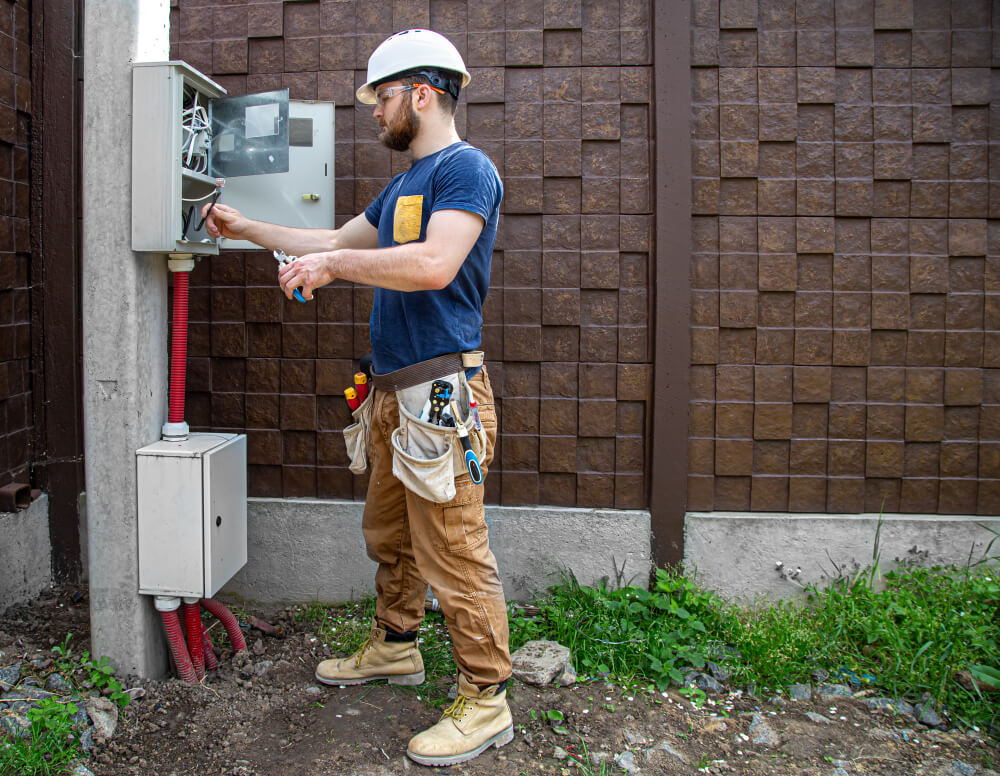Maintenance of the exteriors is complex and challenging for the owners and property managers. It is just not about aesthetics, exterior maintenance is important to ensure the safety, comfort, and overall well-being of the residents. The exterior of the property are the places and things outside the house like the driveway, sidewalk, sewage system, exterior lighting, porches or decks, etc. It is crucial to keep in mind that even exteriors are taken into account while forming NSPIRE and REAC scores during inspections, so you have to ensure that there is no problem in the exteriors.



In this blog, we will dive deep and give 10 exterior maintenance tips that property owners and managers need to look after for compliance with state and federal laws. Let’s dive into each one of these one by one.
- Regular Inspections
The first step in maintaining the exterior of the property is regular inspections so that you can address any issues before they escalate. If the problems are not addressed in time they can pose a safety or health hazard.
So, let’s have a look at how you can do regular inspections and some tips for it:
- Create an inspection schedule: You should inspect your property quarterly, with a more thorough inspection once a year, depending on its size and location. Some key times for inspections include before and after extreme weather events, like winter for cold climates or hurricane season for coastal areas where you have to winterize the property.
- Use a checklist: Make a checklist that specifies the areas to inspect as well as specific elements to look for. Your checklist should include items like landscaping, lighting, building exteriors, walkways, and safety features. Be sure to consider fair housing requirements in your checklist, such as accessibility features for residents with disabilities.
- Document your findings: Make sure to thoroughly document your findings during inspections, including photographs and descriptions of issues. It is useful for tracking progress and demonstrating compliance with fair housing regulations when it serves as a historical record of property maintenance.
- Immediate actions: After an inspection, if there are safety hazards, structural problems, or non-compliance with fair housing requirements, take immediate action. The sooner you respond, the less likely you are to have accidents, damage, and legal problems.
- Landscaping and Grounds Maintenance:
Maintaining the landscaping like clear walkways, maintaining lawns, trimming bushes, and removing dead trees and branches will not only help keep the aesthetic and beauty, but it will help in avoiding any hazards to the residents. You should keep doing regular maintenance and inspect trees on your property for signs of disease, dead branches, or other safety hazards. Prune or remove dead or dangerous branches promptly to prevent accidents and potential property damage.
Also, depending on your location and climate, landscaping tasks may vary with the seasons. You must plan your landscaping maintenance accordingly. For instance, spring and summer are the peak growing seasons when regular lawn mowing, weeding, and pruning are needed. Fall may require leaf removal, while winter might involve protective measures for plants in cold climates.
Here are some extra tips for landscaping and ground maintenance:
- Diversity in Planting: You should choose a variety of plants, including native species, to enhance biodiversity and promote a healthy ecosystem while complying with fair housing guidelines. Native plants are often low-maintenance and better suited to local conditions.
- Efficient Irrigation: Implement efficient irrigation systems, such as drip irrigation, to conserve water and reduce utility costs. Watering should be done early in the morning or late in the evening to minimize evaporation.
- ADA-Compliant Landscaping: Ensure that your landscaping plan includes features that make your property accessible to residents with disabilities. This might involve installing ramps, accessible pathways, and appropriate seating areas.
- Consider Sustainable Practices: Embrace sustainable landscaping practices by using environmentally friendly mulch, composting yard waste, and avoiding harmful chemical pesticides and herbicides.
- Engage Residents: Encourage residents to participate in community gardening or landscaping initiatives to promote a sense of ownership and pride in the property.
- Adequate Lighting
Outdoor lighting is an important aspect of the security and safety of the residents. It creates a well-lit environment in common areas, walkways, and parking lots, reducing the risk of accidents and discouraging criminal activity.
Here are some additional tips to manage and maintain adequate lightning on the exteriors of the property:
- Energy-Efficient Lighting Choose energy-efficient lighting options, such as LED fixtures, which consume less energy and last longer. This choice not only reduces operational costs but also aligns with sustainability goals.
- Maintenance: Make sure lighting fixtures are regularly inspected and maintained so they remain functional. This includes cleaning, bulb replacement, and addressing issues like flickering lights or damaged fixtures.
- Timers and Dimmers: Implement timers and dimmers to control lighting based on the time of day. This can help save on operational costs by reducing unnecessary nighttime illumination.
- Emergency Lighting: Make sure emergency lighting is in operation at all times, including in common areas, stairways, and exits.
- Dark Sky Lighting: Consider “dark sky” principles when designing your lighting plan to reduce light pollution and minimize the impact on the environment and the night sky.
- Paint and Exterior Finishes
You should look into the paint and exterior finishes like fading, chipping, or peeling paint because it can not only affect curb appeal but may also lead to structural issues. Neglecting these areas can lead to issues like leaks and water damage.
Here are a few things that you need to keep in mind while doing paint and exterior maintenance:
- Surface Preparation: Before repainting, prepare the surfaces by cleaning, scraping, and sanding to remove loose or damaged paint. Repair any underlying structural damage, such as rot or cracks, before applying new paint or finishes.
- Quality Paint: Invest in high-quality paint and finishes to ensure durability. Quality products tend to last longer and provide better protection against the elements.
- Protective Coatings: In regions with extreme weather conditions, consider applying protective coatings to extend the life of the paint and provide additional protection against the elements.
- Historic Properties: If you manage historic properties, consult with experts on historic preservation to ensure compliance with preservation guidelines while maintaining the building’s historical integrity.
- Roof Maintenance:
The roof plays an important role in protecting the property and its occupants from the elements. Regular maintenance of your roof can prevent leaks, structural damage, and health hazards. Having a sound roof contributes greatly to the overall safety and comfort of a home.
- Sidewalks and Driveways:
To prevent tripping hazards, maintain sidewalks and driveways. If there are any cracks or potholes, they need to be repaired right away. To comply with fair housing requirements, ensure pathways are wide and accessible for residents with disabilities.
Here are some of the additional things that you need to consider:
- Non-Slip Surfaces: Use non-slip coatings or materials on sidewalks and driveways to reduce the risk of slipping, especially in wet or icy weather.
- Proactive Snow and Ice Removal: During winter, ensure that sidewalks and driveways are kept clear by establishing a proactive snow and ice removal plan.
- Resident Feedback: Encourage residents to report sidewalk and driveway issues promptly, creating a collaborative approach to maintenance and safety.
- Repaving: If the sidewalk or driveway deteriorates significantly, consider repaving or resurfacing the surface for long-term accessibility and safety.
- Compliance Training: Educate your property management team about fair housing requirements, particularly those related to accessibility. Ensure they understand the necessity of adhering to these guidelines in maintaining sidewalks and driveways.
- Gutters and Drainage
To protect your property from water damage, it is crucial to have properly functioning gutters and drainage systems. When it rains, these systems divert rainwater away from the building, preventing water infiltration that can lead to structural issues, mold growth, and costly repairs. Be sure to keep an eye on the septic tanks to make sure there are no septic system problems like leaks or bad odors.
Here are some of the things that you need to consider:
- Downspout Placement: Make sure that downspouts direct water away from the building’s foundation. You can channel water further from the structure by using extensions or splash blocks.
- Gutter Guards: If you want to reduce the amount of debris entering your gutters, consider installing gutter guards or screens. This can help minimize clogs and maintenance needs.
- Water Management: Check the property’s grading and landscaping to ensure water flows naturally away from the building. The installation of swales or the use of rain barrels for water storage can be beneficial adjustments.
- Professional Inspection: Check for hidden issues or damage during routine maintenance by scheduling a professional inspection periodically.
- Seamless Gutters: If you have sectional gutters, consider replacing them with seamless gutters, which have fewer joints and seams, reducing the possibility of leaks and clogs
- Pest Control
You must be familiar with the health code violations regarding the control of the pest for managers and landlords. Implement integrated pest management practices to minimize the use of harmful chemicals, making your property more environmentally friendly.
There are two ways for pest management in the properties:
- Integrated Pest Management (IPM): Use IPM practices to prevent, monitor, and control pests in the least harmful way, with the least amount of harm. This approach may include using traps, sealing entry points, and reducing food and water sources for pests.
- Professional Pest Control Services: If necessary, hire a pest control company that has experience in environmentally friendly pest control. They can provide expert guidance and use eco-friendly treatments.
- Playground and Recreational Areas
It is vital for residents, especially families with small children, to have parks and recreational areas where they can enjoy and socialize. Ensure that these areas are maintained regularly to ensure their safety, functionality, and compliance with fair housing regulations, which often require accessible and safe facilities.
- Address Accessibility
One of the core principles of fair housing in the US is ensuring accessibility for residents with disabilities. You can make accommodations for accessibility for residents disabled by installing ramps, handrails, and accessible parking spaces. Make sure they are regularly inspected to ensure they are functioning properly.
Here are some tips to work on address accessibility:
- Residents with Disabilities: You should provide an open and welcoming environment for residents with disabilities. Listen to their feedback and address any concerns or suggestions they may have regarding accessibility.
- Educate Staff: Ensure that your property management team is knowledgeable about fair housing requirements and accessibility accommodations. Regular training can help keep everyone informed.
- Emergency Accessibility: Make emergency plans that include accommodations for residents with disabilities, such as evacuation routes and communication methods.
- Accessible Communication: Provide information about accessibility features and procedures for requesting accommodations in a clear and accessible manner for all residents.
End Note
Exterior maintenance is not just about keeping your property looking good; it’s about providing safe, comfortable, and accessible housing for all residents. By following these ten exterior maintenance tips, owners and property managers can play a vital role in upholding fair housing laws and providing affordable housing options. Your commitment to maintaining the exterior of your properties can make a significant difference in the lives of your residents, creating a welcoming and inclusive environment for all. Explore our website for more such helpful information, and get free webinar training from the experts in the industry.




